Barkhor Street: Where Tradition Meets Modern Tibetan Life
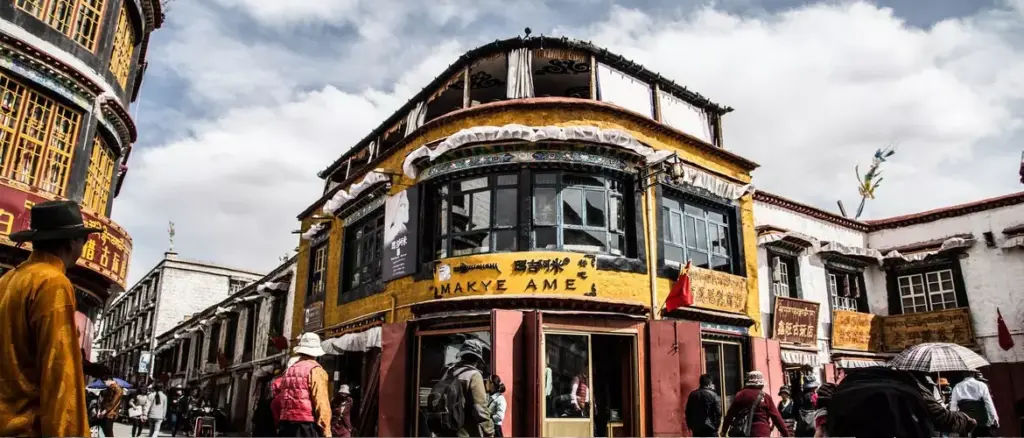
An Essential Guide to Visiting Barkhor Street
Nestled in the heart of Lhasa, Barkhor Street is not just a thoroughfare; it’s a vibrant tapestry woven from threads of spirituality, culture, and commerce. As you step onto this ancient path, you are transported into a world where the past and present seamlessly coexist. Originally a sacred pilgrimage route encircling the revered Jokhang Temple, Barkhor has blossomed into a bustling bazaar, inviting travelers and locals alike to immerse themselves in its rich traditions.
Imagine walking alongside devout pilgrims, their prayer wheels spinning rhythmically as they chant mantras, all while the enticing aromas of Tibetan delicacies waft through the air. The street is alive with color and sound, showcasing a delightful array of handcrafted goods and exotic souvenirs from neighboring regions like Nepal and India. Each stall you pass offers a glimpse into the artistry and craftsmanship that define Tibetan culture, making it a treasure trove for those seeking unique keepsakes.
Whether you’re here to shop, savor local cuisine at charming eateries, or simply soak in the spiritual atmosphere, Barkhor Street promises an experience that resonates deeply with the soul. This essential guide will equip you with everything you need to navigate the twists and turns of this captivating locale, ensuring your visit is as enriching as it is memorable.
In This Guide
- An Essential Guide to Visiting Barkhor Street
- The Rich History and Legends of Barkhor Street
- Main Highlights: What You Absolutely Can’t Miss
- Planning Your Visit: A Practical Guide
- Tickets: Prices, Booking, and Tips
- How to Get There: A Complete Transportation Guide
- Local Cuisine and Accommodation Nearby
- Frequently Asked Questions
- Final Thoughts on Your Trip
The Rich History and Legends of Barkhor Street
Nestled in the heart of Lhasa, Barkhor Street is not just a thoroughfare; it is a living testament to Tibet’s rich history and vibrant culture. This ancient street, revered as the “heart of Lhasa,” has served as a sacred pilgrimage circuit for centuries, drawing devotees from all corners of Tibet and beyond. Its origins can be traced back to the 7th century when King Songtsen Gampo, the founder of Lhasa, constructed the magnificent Jokhang Temple. This temple became the focal point of spiritual life in Tibet, and Barkhor Street emerged as a pathway for pilgrims circling the sacred site.
Originally a simple path around Jokhang Temple, Barkhor Street has evolved into a bustling bazaar and cultural hub. Over time, it expanded into a larger circuit that includes Barkhor East, West, South, and North Streets, encompassing a circumference of approximately 1,000 meters. As you stroll through this lively area, you are transported back in time, surrounded by the echoes of ancient Tibetan traditions and the aroma of local delicacies wafting from nearby eateries.
The street is alive with the rhythm of devotion, as pilgrims walk clockwise around the Jokhang Temple, spinning prayer wheels and murmuring mantras. This captivating scene is a daily reminder of the deep spiritual roots that underpin Tibetan culture. The air is thick with a sense of reverence, as each prostration and prayer weaves the fabric of history into the present moment.
Barkhor Street is also a treasure trove of cultural artifacts and local craftsmanship. Here, you can find an array of traditional Tibetan costumes, intricate handicrafts, and exotic souvenirs from neighboring regions such as Nepal, India, and Bhutan. The vibrant marketplace offers a unique shopping experience, where bargaining with local vendors is part of the fun. Whether you’re looking for handmade jewelry, colorful thangka paintings, or religious items, Barkhor Bazaar promises an authentic taste of Tibetan artistry.
Beyond shopping and spiritual exploration, the street is dotted with local restaurants where you can indulge in traditional Tibetan cuisine. Establishments like Makye Ame and Guangming Sweet Teahouse invite you to savor local flavors while soaking in the surrounding ambiance. Each meal becomes an opportunity to connect with the culture and history of this remarkable place.
In addition to its bustling marketplace and sacred atmosphere, Barkhor Street is surrounded by historical sites that reflect Lhasa’s rich heritage. Just a stone’s throw away, you can explore the former site of the Qing Government in Tibet or visit the Gendun Choephel Memorial Hall, dedicated to one of Tibet’s most influential intellectuals.
Visiting Barkhor Street is an essential part of any journey to Lhasa. It embodies the spirit of a city that has withstood the test of time, where history, spirituality, and daily life intertwine seamlessly. As you walk its ancient paths, you not only witness the essence of Tibetan culture but also become part of a story that has been unfolding for over a millennium.
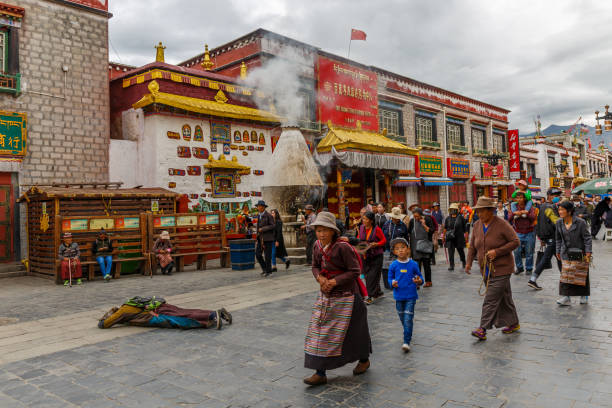
Barkhor Street.
Main Highlights: What You Absolutely Can’t Miss
Barkhor Street, often described as the pulsating heart of Lhasa, is a vibrant blend of spirituality, culture, and local commerce. Here are the main highlights that you absolutely can’t miss when you visit this iconic Tibetan thoroughfare:
1. Jokhang Temple
At the center of Barkhor Street lies the revered Jokhang Temple, a UNESCO World Heritage Site and the spiritual nucleus of Tibetan Buddhism. Make sure to take a moment to explore its richly adorned interiors and witness the fervent devotion of pilgrims. The temple’s golden roofs glimmer under the sun, offering stunning photo opportunities.
2. Barkhor Kora
Participating in the Barkhor Kora is a must. This sacred pilgrimage route encircles the Jokhang Temple, where you’ll find locals and visitors alike walking clockwise, spinning prayer wheels, and murmuring mantras. Joining this ancient ritual allows you to immerse yourself in the deep spiritual culture of Tibet while enjoying the vibrant atmosphere.
3. Barkhor Bazaar
The bustling Barkhor Bazaar is an essential stop for anyone looking to take home a piece of Tibet. Here, you can shop for unique souvenirs, from traditional handicrafts and jewelry to colorful Tibetan rugs and religious artifacts. Don’t forget to practice your bargaining skills with the friendly local vendors!
4. Culinary Delights
After a day of exploration, treat your taste buds at one of the many local eateries. Restaurants like Makye Ame and Guangming Sweet Teahouse offer authentic Tibetan dishes that are sure to delight. Sample local favorites such as momos (dumplings) and thukpa (noodle soup) for an unforgettable culinary experience.
5. Cultural Sites
Beyond the temple, Barkhor Street is flanked by intriguing cultural sites. Visit the Gendun Choephel Memorial Hall to learn about Tibetan culture and history. The Qing Government in Tibet Grand Minister Administrative City is another historical gem that reflects the region’s rich past and governance.
6. Traditional Costumes and Local Life
As you wander through Barkhor Street, take the time to observe the traditional Tibetan costumes worn by locals. The vibrant colors and intricate designs tell stories of Tibetan heritage. Engaging with the locals, who are often seen going about their daily lives, will provide a deeper understanding of the rich cultural tapestry of Lhasa.
7. Scenic Views
Keep your camera ready as you stroll around Barkhor Street. The backdrop of the majestic Potala Palace and the surrounding mountains offers breathtaking vistas. Sunset is particularly enchanting, casting a golden glow over the ancient streets and temples.
8. Spiritual Experience
Lastly, don’t miss the opportunity to reflect and meditate within the ambiance of Barkhor Street. The combination of prayer flags fluttering in the breeze, the sound of chanting, and the smell of incense creates a unique spiritual experience that resonates with visitors, offering a sense of peace and connection.
Barkhor Street is more than just a destination; it’s an experience that encapsulates the essence of Tibetan life and culture. Embrace every moment, and let the magic of this historic street leave a lasting impression on your journey through Tibet.
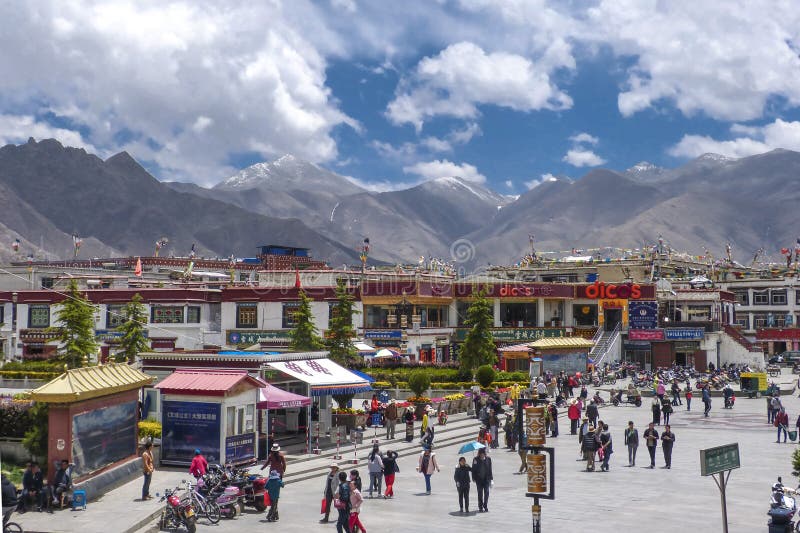
Barkhor Street.
Planning Your Visit: A Practical Guide
Planning Your Visit to Barkhor Street
Barkhor Street is not just a bustling marketplace, but also a vibrant pilgrimage circuit that embodies the spiritual heart of Lhasa. To ensure you make the most of your visit to this iconic location, here’s a practical guide to help you navigate your experience seamlessly.
Getting There
Barkhor Street is situated in the Chengguan District of Lhasa, easily accessible by various modes of transport:
- By Bus: Take local buses No. 6, 9, or 25 and disembark at the Health Care Center Station. From there, it’s just a short walk to the heart of Barkhor Street.
- By Taxi: Taxis are readily available throughout Lhasa. Simply instruct the driver to take you to Barkhor Street, and you’ll be dropped off near the entrance.
Best Time to Visit
Barkhor Street can be visited year-round, but the best time to explore is during the warmer months from April to October. During these months, the weather is milder and ideal for walking. Early mornings or late afternoons are particularly enchanting times to witness both the local pilgrims and the street’s vibrant atmosphere.
Exploring Barkhor Street
-
Experience the Barkhor Kora: Join the local pilgrims in their ritual of circumambulating the Jokhang Temple. The Kora is not just a walk; it’s a spiritual journey that offers insights into Tibetan Buddhism. Take a moment to observe the devotion of the pilgrims and perhaps even spin a prayer wheel yourself.
-
Shop at Barkhor Bazaar: The street is lined with shops selling a variety of traditional Tibetan handicrafts, clothing, and souvenirs. This is the perfect place to purchase unique gifts, from handwoven carpets to intricately designed jewelry. Don’t forget to haggle for the best price!
-
Savor Local Cuisine: After a long day of exploring, treat yourself to some delicious Tibetan food. Notable eateries like Makye Ame and Guangming Sweet Teahouse offer authentic dishes that are sure to satisfy your taste buds. Be sure to try traditional items like momos (dumplings) and butter tea.
-
Visit Nearby Attractions: While Barkhor Street itself is a treasure trove, it’s also close to several other significant sites. Don’t miss the chance to visit the Potala Palace and the Norbulingka, both of which are easily reachable from Barkhor.
Practical Tips
-
Altitude Awareness: Lhasa sits at an elevation of 3,650 meters (11,975 feet). If you’re coming from lower altitudes, be sure to acclimatize properly. Stay hydrated and take it easy on your first few days.
-
Respect Local Customs: As you navigate the street, remember to be respectful of the local customs and traditions. If you see pilgrims prostrating, give them space, and avoid walking through their paths.
-
Stay Connected: Wi-Fi is available in many cafes and some hotels, but consider purchasing a local SIM card to stay connected during your explorations.
-
Cash is King: While some shops may accept credit cards, many vendors prefer cash. It’s advisable to carry some Chinese yuan for your purchases.
Conclusion
Barkhor Street offers an authentic glimpse into the heart of Tibet, combining spirituality, culture, and commerce. With this guide, you’re well-equipped to enjoy all that this historic street has to offer, ensuring your visit to Lhasa is both memorable and enriching. Whether you’re there for the sacred pilgrimage or the vibrant market scene, Barkhor Street is a must-see on your Tibetan adventure.
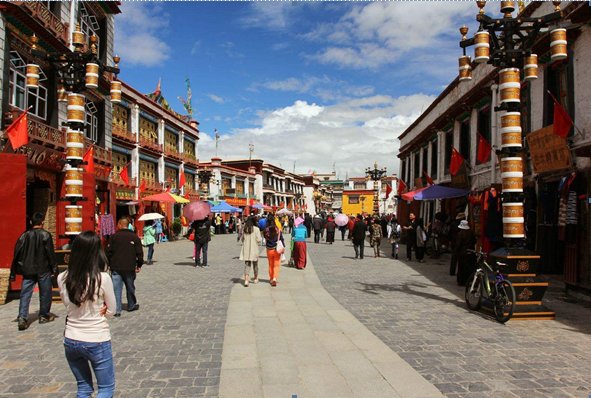
Barkhor Street.
Tickets: Prices, Booking, and Tips
Visiting Barkhor Street in Lhasa is a remarkable experience, blending spirituality, culture, and vibrant market life. Here’s everything you need to know about accessing this iconic location, including ticket information, booking options, and valuable tips for your journey.
Entrance and Ticket Information
Cost: Visiting Barkhor Street is completely free! There are no entrance fees, allowing you to immerse yourself in the rich tapestry of Tibetan culture without any financial barriers.
Opening Hours: Barkhor Street is open every day, making it convenient for travelers to explore at their own pace. The bustling atmosphere and colorful stalls are particularly lively from morning until late afternoon.
Getting There
Transportation Options:
– Public Bus: You can easily reach Barkhor Street by taking bus numbers 6, 9, or 25. Get off at the Health Care Center Station, which is just a short walk away from the street’s entrance.
– Taxi: For a more direct route, taxis are readily available throughout Lhasa. Just provide the driver with your destination, and you’ll be dropped off near the heart of the action.
Booking Tours
While you don’t need a ticket to enter Barkhor Street, many travelers choose to book guided tours to enhance their experience. Here are some popular options:
- 4 Days Lhasa Impression Small Group Tour – Explore the essence of Tibet with local insights. Prices start from $509 per person.
- 8 Days Lhasa to Everest Base Camp Small Group Tour – A breathtaking journey that includes a visit to Barkhor Street. Prices start from $949 per person.
- 15 Days Kailash and Manasarovar Tour – For those looking to delve deeply into Tibetan spirituality, this extensive tour starts at $2069 per person.
Booking in advance is recommended, especially for popular tours. Many operators offer early bird discounts, so keep an eye out for special deals!
Tips for Your Visit
- Timing: The best time to visit Barkhor Street is early in the morning or late afternoon. This allows you to witness the pilgrims in action and enjoy a more serene shopping experience.
- Dress Appropriately: Lhasa sits at an altitude of 3,650 meters (11,975 feet). Dress in layers to adapt to the temperature changes throughout the day.
- Stay Hydrated: The high altitude can lead to dehydration, so make sure to drink plenty of water during your explorations.
- Bargaining: If you plan to shop, be prepared to haggle for the best prices at the market stalls. It’s part of the experience and can be quite enjoyable!
- Cultural Respect: Remember that Barkhor Street is a pilgrimage site, so be mindful of the local customs and the devout pilgrims around you.
With its rich history and vibrant atmosphere, Barkhor Street is a must-visit for anyone traveling to Lhasa. Enjoy your journey through this enchanting part of Tibet!
How to Get There: A Complete Transportation Guide
Reaching Barkhor Street, the vibrant heart of Lhasa, is an exciting prelude to your exploration of this ancient city. Whether you’re arriving from the airport, train station, or another part of Lhasa, there are several convenient transportation options to consider.
Getting to Barkhor Street
Arriving by Air
If you’re flying into Lhasa Gonggar Airport (LXA), which is approximately 60 km (37 miles) from the city center, the most efficient way to reach Barkhor Street is by taxi or shuttle bus.
- Taxi: Taxis are available outside the terminal and will take you directly to Barkhor Street in about 1.5 hours. Expect to pay around CNY 200-300.
- Shuttle Bus: The airport shuttle bus runs regularly between the airport and Lhasa city. You can catch it at the airport for around CNY 40. The bus will drop you off at designated stops in the city, from where you can take a taxi or walk to Barkhor Street.
Arriving by Train
Lhasa Railway Station is well-connected, with trains arriving from major cities like Beijing, Chengdu, and Xining. The station is approximately 10 km (6 miles) from Barkhor Street.
- Taxi: A taxi ride from the train station will take about 20 minutes and cost around CNY 30-50.
- Public Bus: Take Bus No. 6 or No. 25 from the train station to the Health Care Center Station. From there, it’s just a short walk to Barkhor Street.
Local Transport Options
Once you’re in Lhasa, navigating to Barkhor Street is straightforward:
-
Buses: The local bus system is efficient. To reach Barkhor Street, you can take Bus No. 6, No. 9, or No. 25. Disembark at the Health Care Center Station, and follow the signs or ask locals for directions.
-
Taxis: Taxis are widely available throughout Lhasa. Simply hail one from the street or ask your hotel to arrange a ride. The fare from any major attraction in Lhasa to Barkhor Street should not exceed CNY 20-30.
Walking
If you’re staying in central Lhasa, many attractions are within walking distance of Barkhor Street, including the iconic Jokhang Temple and the Potala Palace. Walking is a great way to immerse yourself in the local atmosphere and enjoy the beautiful architecture along the way.
Tips for Travelers
- Altitude Considerations: Lhasa sits at an altitude of 3,650 m (11,975 ft). Ensure you acclimatize properly before undertaking any strenuous activities.
- Local Currency: Have some cash on hand, as some vendors in the Barkhor Bazaar may not accept credit cards.
- Language Barrier: While many locals understand basic Mandarin, English speakers may be less common. Learning a few basic Tibetan phrases can enhance your experience.
With these transportation options at your disposal, getting to Barkhor Street will be a breeze, allowing you to dive straight into the rich cultural tapestry of Lhasa!
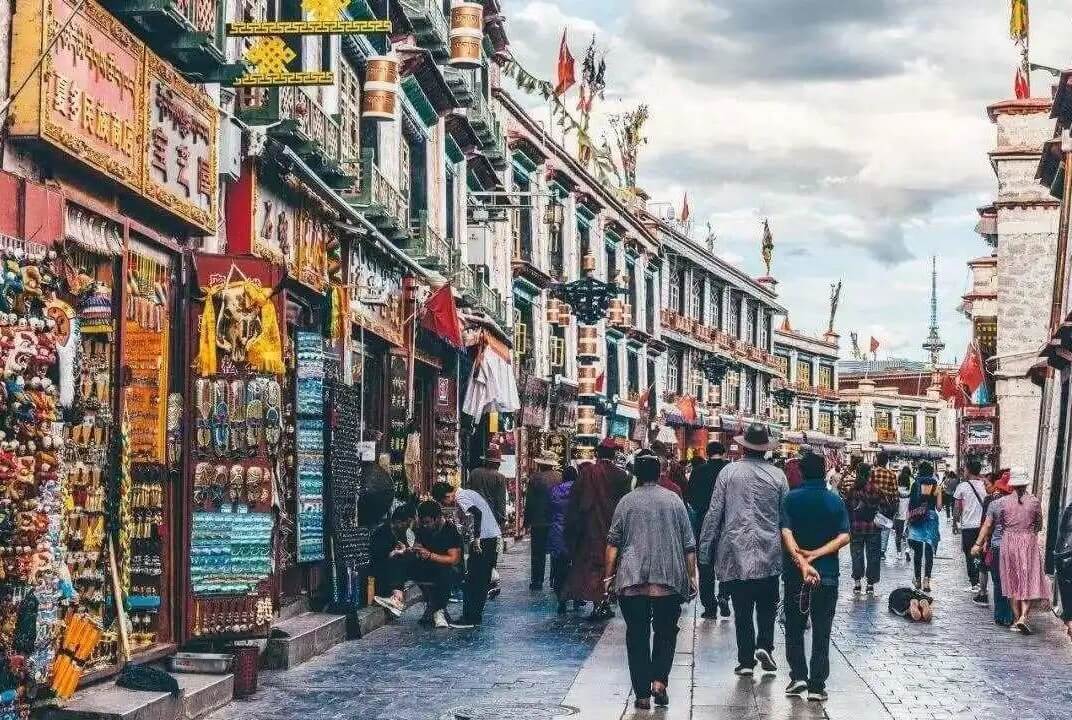
Barkhor Street.
Local Cuisine and Accommodation Nearby
When exploring the vibrant and historic Barkhor Street in Lhasa, you’ll find yourself surrounded by a rich tapestry of flavors and accommodations that reflect the unique culture of Tibet. Here are some top recommendations for indulging in local cuisine and finding a comfortable place to rest after a day of exploration.
Culinary Delights
- Makye Ame
-
Located just a stone’s throw from the Jokhang Temple, this restaurant is a must-visit for authentic Tibetan dishes. Known for its cozy ambiance, Makye Ame serves traditional fare such as thukpa (noodle soup) and momos (dumplings). Don’t miss out on their yak butter tea, a local favorite that warms you up after a day in the high altitude.
-
Guangming Sweet Teahouse
-
A popular hangout spot for both locals and tourists, this teahouse offers a variety of teas and light snacks. It’s the perfect place to take a break and watch the bustling activity on Barkhor Street. Try their sweet milk tea paired with traditional Tibetan pastries for a delightful afternoon treat.
-
Tibetan Family Kitchen
-
For a more home-cooked experience, head to this charming establishment. Run by a local family, the menu features dishes made with fresh ingredients and traditional recipes. The vegetable curry and barley bread are standout choices that give you a taste of authentic Tibetan hospitality.
-
Tashi Restaurant
- Just off Barkhor Street, Tashi Restaurant is known for its extensive menu that includes both Tibetan and international dishes. Whether you’re in the mood for spicy yak stir-fry or a comforting vegetarian platter, Tashi has something for everyone. The friendly staff and warm atmosphere make it a perfect dining spot.
Comfortable Stays
- Barkhor Inn
-
Nestled right on Barkhor Street, this inn offers travelers a blend of comfort and convenience. The rooms are decorated in traditional Tibetan style, providing a unique atmosphere that complements your Lhasa experience. Plus, you’re just steps away from the bustling marketplace and sacred sites.
-
House of Shambhala
-
This boutique hotel provides a tranquil retreat in the heart of the action. With beautifully designed rooms that showcase Tibetan decor, guests can enjoy modern amenities alongside cultural authenticity. The hotel also features a lovely courtyard where you can unwind after a day of sightseeing.
-
Lhasa Hotel
-
A bit further from the main street, the Lhasa Hotel offers a more upscale option for those looking to indulge. It boasts spacious rooms and a range of facilities, including a restaurant that serves both local and international cuisine. It’s a great base for exploring all that Lhasa has to offer.
-
Tibet Gorkha Hotel
- Located near Barkhor Street, this hotel is known for its friendly service and comfortable accommodations. With a mix of Tibetan and Nepali influences, the hotel provides a cozy atmosphere and is an ideal choice for budget travelers seeking easy access to local attractions.
Conclusion
Whether you’re savoring the rich flavors of Tibetan cuisine or finding a peaceful spot to rest, the area surrounding Barkhor Street offers an array of options that cater to all tastes and budgets. Embrace the local culture, meet fellow travelers, and enjoy the unique culinary experiences that make your journey to Lhasa truly unforgettable.
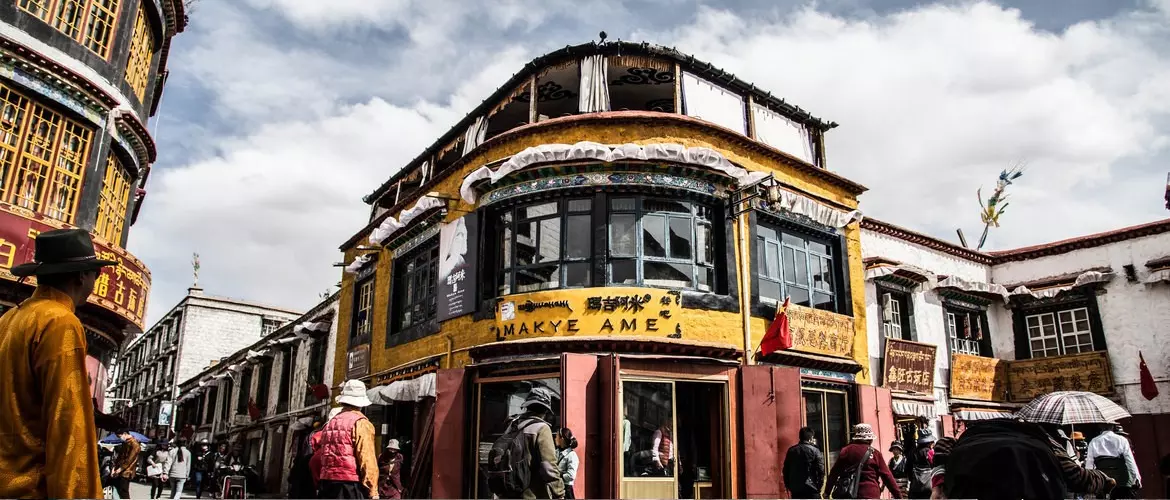
Barkhor Street.
Frequently Asked Questions
-
What is Barkhor Street and why is it significant?
Barkhor Street, also known as Bakuo Street, is the oldest street in Lhasa and serves as a crucial pilgrimage circuit surrounding the Jokhang Temple. It is a vibrant marketplace filled with traditional Tibetan handicrafts, local foods, and an authentic atmosphere that reflects the spiritual and cultural heart of Tibet. -
What are the opening hours for Barkhor Street?
Barkhor Street is open 24 hours a day, allowing visitors to explore its bustling atmosphere at any time. However, many shops and restaurants typically operate from around 9:00 AM to 4:00 PM. -
Is there an entrance fee to visit Barkhor Street?
No, there is no entrance fee to explore Barkhor Street. It is free to roam around the street, enjoy the sights, and engage with local vendors. -
How can I get to Barkhor Street?
You can reach Barkhor Street by taking public buses No. 6, 9, or 25 and getting off at the Health Care Center Station. Taxis are also a convenient option if you prefer a direct route. -
What should I wear when visiting Barkhor Street?
Due to its high altitude (3,650 m or 11,975 ft), it’s advisable to dress in layers to accommodate temperature changes throughout the day. Comfortable walking shoes are essential, as you’ll likely be walking a lot, especially if you plan to join the pilgrim circuit. -
Are there any recommended restaurants or food spots along Barkhor Street?
Yes! Some popular dining spots include Makye Ame and Guangming Sweet Teahouse, where you can savor authentic Tibetan cuisine and enjoy local delicacies. Don’t miss out on trying traditional dishes like momos (dumplings) and butter tea. -
What unique items can I shop for at Barkhor Street?
Barkhor Street is a treasure trove for unique souvenirs, including traditional Tibetan crafts, thangka paintings, jewelry, and religious artifacts. It’s the perfect place to find gifts that reflect the rich cultural heritage of Tibet. -
Can I participate in the Barkhor Kora as a visitor?
Absolutely! Visitors are welcome to join the Barkhor Kora, where you can walk alongside local pilgrims who circumambulate the Jokhang Temple. This is a meaningful way to experience Tibetan culture and spirituality while enjoying the scenic surroundings.
Final Thoughts on Your Trip
As your journey through Barkhor Street comes to a close, take a moment to reflect on the rich tapestry of experiences that this vibrant area has woven into your travels. From the serene presence of devout pilgrims to the lively buzz of local vendors, Barkhor Street is not just a destination but a living testament to Tibetan culture and spirituality.
The sights, sounds, and flavors of this ancient street will linger in your memory long after you leave. Whether you found a unique souvenir to remind you of your adventure or indulged in the delights of local cuisine, each moment spent here has deepened your connection to the heart of Lhasa.
Remember, the allure of Barkhor Street lies in its ability to unite people from all walks of life, inviting you to become part of its enduring story. As you step away from the bustling bazaar and the sacred Jokhang Temple, carry with you the warmth of Tibetan hospitality and the spirit of exploration that this remarkable place embodies. Your adventure in Barkhor Street may end, but the journey within you continues. Safe travels!